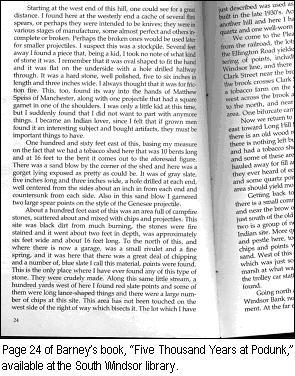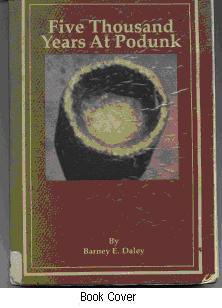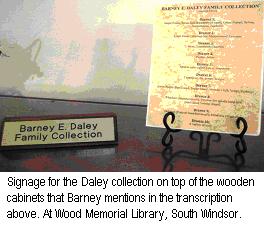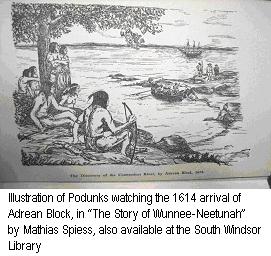
REPRINTS

Ed. Note: Author, historian, and collector Barney Daley presented his "Indian Artifact" slide show to the D.A.R.
at the Manchester History Center on March 10, 2005, granting permission to tape-record his talk.
 Manchester Historical Society volunteer
Linda Laplante transcribed it. I have edited it somewhat because the pictures themselves (Barney�s celluloid slides) are
not available to me.
Manchester Historical Society volunteer
Linda Laplante transcribed it. I have edited it somewhat because the pictures themselves (Barney�s celluloid slides) are
not available to me.
The Daley family farmed in South Windsor and collected many Indian artifacts there. The collection of more than 5,000
artifacts is archived and some is on display at the Wood Memorial Library in South Windsor. Read about "The Wood's" collections at:
Collections.
Barney wrote "Five Thousand Years at Podunk," and other books about South Windsor pre-history and history. I have not
included transcription that just names the item in the slide, such as, "This is an arrowhead."
The first slide is of an archeological dig at the University of Connecticut, and subsequent slides are of maps and
artifacts. Here is the abridged transcription of Barney�s talk. � Susan Barlow, editor and webmaster.
Barney Daley: This is a dig at UConn. They are working on a dig there and they found some corn that was charred
and the outline of a basket and the skeleton of a ten-year-old boy. When they got through identifying it, they covered it
all over again. It�s still there. That�s more digs. When they get shoveling down there it gets to 110-120 degrees down
there. When we discovered the two skeletons and UConn dug them out, the flood was coming up and we had to hurry to get out
before the flood covered it over. They got the last bones out of there and our feet were getting wet. I brought the last
load out and this lady professor preferred to sit in the back of the truck with the skeleton rather than sitting up front
where it was warm with me. So what they did was uncover these bones and then paint them with acetate or acetone, whatever
it is, to harden them because if they didn�t harden them they would disintegrate.
That�s pottery, and those are maps. Those are shells they used for spoons.
That�s a bowl that Gladys [editor�s note: Dr. Gladys Iola Tantaquidgeon, Mohegan Medicine Woman, 6/15/1899-11/1/2005],
found. ...she was hopping up and down, she was so excited. Those are only outlines and there�s another piece I found where
the Bissell Ferry was. That was used for smoothing bowls; they would put sand in there to smooth it out and round it out.
This piece, nobody has been able to identify. It has a hole right through it. It looks like it would be a weight for
a canoe, but on the end of it, it has chip marks so I don�t know. That�s it [for the Podunks].
Now, going back to the Pequot Indians. They came�from the northwest. This I got from Gladys herself. She said, "When
we came down from the northwest we were Mohicans. The people called us Pequot which is an Indian name for destroyer because
we were invaders and fighters and took over the territory. When we got down here, we had a family feud and split up. So
Uncas and his group, they separated from the other half of the Mohicans and the other half retained the name Pequot."
But according to ... an early historian, early English rulers broke up the Pequot nation and said that they could
never use the name again. But somehow, through politics, they revived the name Pequot which is not actually a tribal name.
Whereas, the Mohican did revive the name. The Mohicans came up this way and being the stronger tribe they took over these
Indians and subjugated them so that they had to pay tribute, whatever it was. So Gladys said to me, "We gave them a lot of
trouble, didn�t we?"
In the long run they were all destroyed. When they came up to Wethersfield, they killed half a dozen people around the
Wethersfield Green area and they took two girls captive, two or three girls. So that precipitated the fight at Mystic.
Captain John Mason went down to Mystic. Uncas�s warriors joined them to wipe out the Pequot. He joined the English that
time.
A while ago, a friend, a historian with the Windsor Historical Society, called us and said, "Come over and see what
has happened to John Mason�s statue." The Pequot didn�t want it down there because of the fact that he destroyed the Pequot
Nation. So the Windsor Historical Society put it on the Green, where the church is, on Palisado, and we went up to see it.
His sword was painted red as though covered with blood. I guess some Loomis Chaffee students must have done it. They
cleaned it up and they had a rededication and they had a representation from the Pequot Nation. This group had signs,
"killer," "murderer," "butcher" and things like that about John Mason, but to be honest John Mason was only giving back
what they gave us. You can�t blame the English because the Pequot started the whole thing. When the English fought people
would take them prisoners. They would sell them as slaves to the Spanish down in the Islands so the Indians got tangled up
with the natives and they produced half breeds down there and when slavery came in they sent all these people and the
southern planters bought them. They came into New Orleans and they spread out. So they say that today what we have in the
Pequot Nation is a mixture of Indians that were captured and Pequot Indians that were sent down. We don�t know what kind
of a mixture so some of the Indians have curly hair today instead of straight brown hair. They have different features
from the Caucasians� features and the original Indians. Well, I think that that is enough. You people probably wish I would
shut up.
[Barney took questions at the end of his talk.]
Q. Were the longhouses used the same as those used by the Iroquois in New York?
A. Same kind. All used the same, down to Pennsylvania, up north. The ones who had the tepee were mostly movers.
They would follow the herds so that they could pick them up and go along with them. The permanent ones, they set the post
right down in the ground. In fact some of them even had beds.
Q. How did you get interested in artifacts and digging up bones?
A. When I was twelve years old, my father bought a tobacco farm and it was just loaded with Indian artifacts.
And besides that, I was a voracious reader. I loved history, so anything in the line of history I gobbled it up. I think I
read every book in the Library by the time I was thirteen. I�d come home with both arms full of books. None were homework.
Gladys Daley, Barney�s wife: Then when I got going with him, we went out into the fields to look. Then he went
into the Service, and then he came back and lived down in Mayberry Village. Then when he got back to South Windsor every
time we had a rainstorm in the spring or summer we would beat the dirt down, we knew with our kids we had to go out in the
fields and look. We would go row by row by row. The kids helped us too to find all these artifacts. It was many years ago
because we got married in 1942. He lived in Mayberry Village in East Hartford after the war. At that time it was all ex
servicemen and people from Maine that came down to work at Pratt & Whitney. So then we built our own house and moved back
up into South Windsor in �49 and have been there ever since.
Barney: They used to come down from Canada to work in the ... mill. It wasn�t a factory, it was a mill to them.
[I think he�s referring to Pratt & Whitney, which some called the Mill or the Aircraft.]
Oh, another thing, when I was young I used to (maybe twenty years old) know Norris Bull � he was a great collector. I
got acquainted with him; he bought some of my stuff. So he had me go out and see if I could find this or that. He had some
piece that was interesting, and I understand from the University of Connecticut that Pequot Museum followed a lot of the
artifacts of Norris Bull and they have them on display down there. I used to visit ... and we got talking about different
things and he would pick up an artifact and say "What�s this," and I�d say I knew what it was, an axe. He would say, "No,
it isn�t, that�s what I want to use it for." He had a point there.
Our collection is over at the Wood Library on Main Street in South Windsor. We paid for two big cabinets. There are
five drawers; the drawers are five and five and five and five. We put foam underneath and blue felt and tend all of those
things. It took us a long time to get all of our stuff over there. It�s on permanent loan to the Wood Library. If something
happens to the Wood Library it goes to the state archeologist at UConn. We got a legal document to say that. It�s safe, to
be protected down through the centuries.
The point of this collection that made it different was the fact that we documented each field from which certain
artifacts came so that we were able to tell what time period each field had Indians on it. Some of the artifacts go to
8,000 years before the present. That�s a long time ago. That�s about the same time as the Middle East. I often wonder to
myself, how do these people here know how to make the same type of tools that they did in the Middle East or in the Solomon
Islands, or Saudi Arabia. They all knew how to make the same tools. How did they get the information? It�s mind boggling.
Well, they learned how to make pottery. How to make pots and bottles. We had a program with the school kids; they were
going to make pots. So they made all these pots and put them outside. They camped out that night and they were drying the
pots around the fire and some kids got up to go to the bathroom and all of a sudden some of the fire started to blaze up
and we got scared and so we threw water on the fire. It put the fire out; it [also] put water around the pots and cracked
them all. So that ended that project.
We used to have some good times taking the kids down and showing them the wildflowers that the Indians used.
Gladys Daley: The kids liked it. They got out of school for half a day to see all the different plants. They
didn�t complain, they liked it.
Susan Barlow: Thank you very much.
[Applause]
 |
 |
 |
 |
Ed. note: Barney Daley passed away on February 25, 2008. To read a reprint of his obituary, please click
Barney Daley Obituary.
Also: For a description of Connecticut Indian demographics at the time of European contact (in the early-mid 1600s),
please refer to a paper by Jim Trocchi, in the Friends of the Office of State Archaeology web site's Reprints section,
by clicking Connecticut Indians.